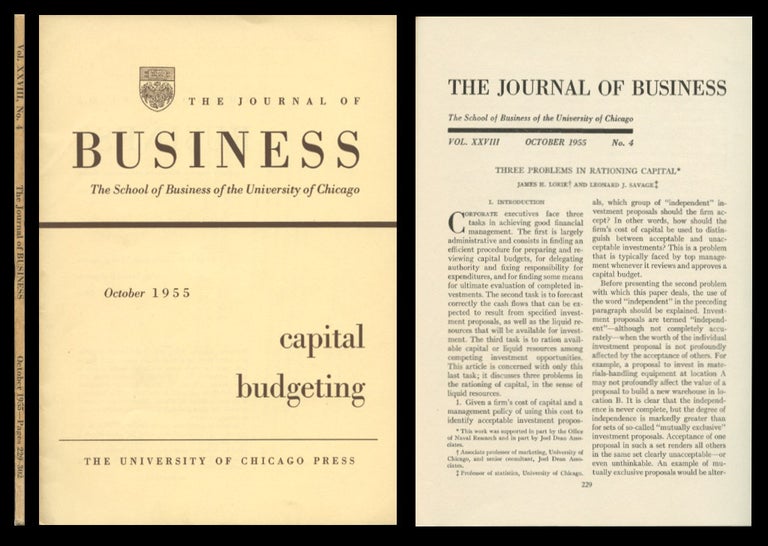Three Problems in Capital Rationing in The Journal of Business 28, 8, October 1955, pp. 229-240
Chicago: The University of Chicago, 1955. 1st Edition. FIRST EDITION IN ORIGINAL WRAPS OF A CLASSIC PAPER ON THE PROBLEM OF CAPITAL BUDGETING, THE 1955 FIRST PRESENTATION OF THE “LORIE-SAVAGE PROBLEM”.
In this paper, Lorie and Savage use integer programming (Lagrangian methods in discrete optimization approach) to introduce the topic of capital budgeting and present their approach for making project selections to maximize value along with three examples to illustrate the approach. Note that this entire issue of The Journal of Business is devoted to capital budgeting and also includes papers by Solomon, Gordon, Dean and Smith, Shillinglaw, Hill, Norton, and Villers.
Project selection is a major problem in managerial decision making. Capital budgeting problems determine which project to fund given constraints on available capital. The much studied “Lorie-Savage Problem” [also known as the Lorie and Savage Problem or the Lorie-Savage Paradox], is the problem of choosing among competitive investment possibilities so as to maximize total payoff. This is the problem’s first appearance in print. Lorie and Savage were the first authors “to consider specifically the rationing of capital to which a company is subject in the problem of choosing real investments” (Gil-Aluja, Handbook of Management, 366)
Lorie and Savage named three problems which they then used to illustrate their approach: “(1) Given the cost of capital, what group of investment projects should be selected; 2) Given a fixed sum for capital investment, what group of investments proposals should be undertaken, and 3) Selecting the best among mutually exclusive alternatives” (Larson, Capital Budgeting, No. 173, January 1970, 3).
Perhaps the clearest statement of the Lorie-Savage Problem came from the man who later used their work as “a basis for setting out the problem of rationalizing capital explicitly in terms of linear programming”, H. Martin Weingartner (Gil-Aluja).
After first stating that the Lorie-Savage Problem employs integer programming, Weingartner describes the problem as follows: “Given the net present value of a set of independent investment alternatives, and given the required outlays for the projects in each of two time periods, find the subset of projects which maximizes the total net present value of the accepted ones while simultaneously satisfying a constraint on the outlays in each of the two time periods. The problem may be generalized to an arbitrary number of time periods and stated formally as an integer programming problem” (Weingartner, On the Capital Budgeting of Interrelated Projects, MIT).
NOTE: Ten years later, in 1965, Baumol and Quandt apply tools of mathematical programming to this same task. We offer that paper separately. Baumol and Quandt’s “Investment and Discount Rates Under Capital Budgeting – A Programming Approach” in The Economic Journal 75, No. 298, June 1965, pp. 317-329. Item #933
CONDITION & DETAILS: Chicago: The University of Chicago. Complete issue in original paper wraps. 4to. (9.5 x 6.5 inches). Continuously paginated pp. 229-301. Very slight toning at the edges of the wraps and on the spine, otherwise bright and very clean inside and out. Very good to near fine condition.
Price: $400.00

